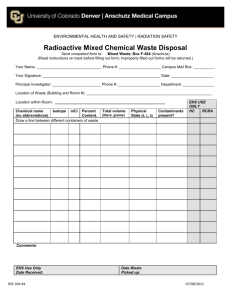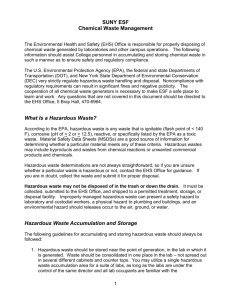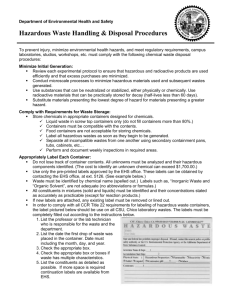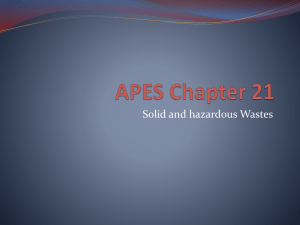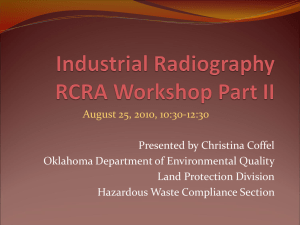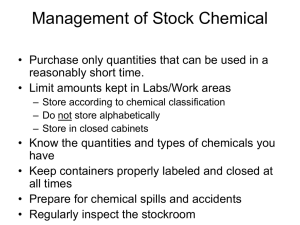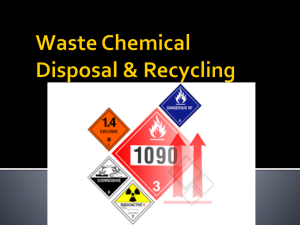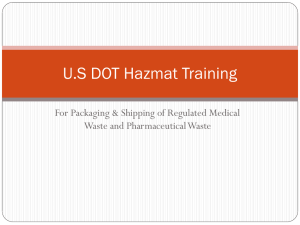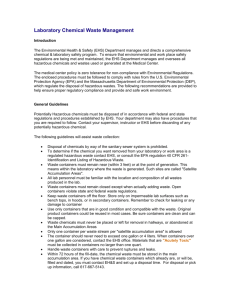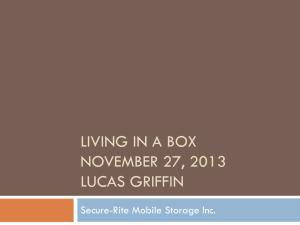Laboratory Environmental Train - University of Houston
advertisement
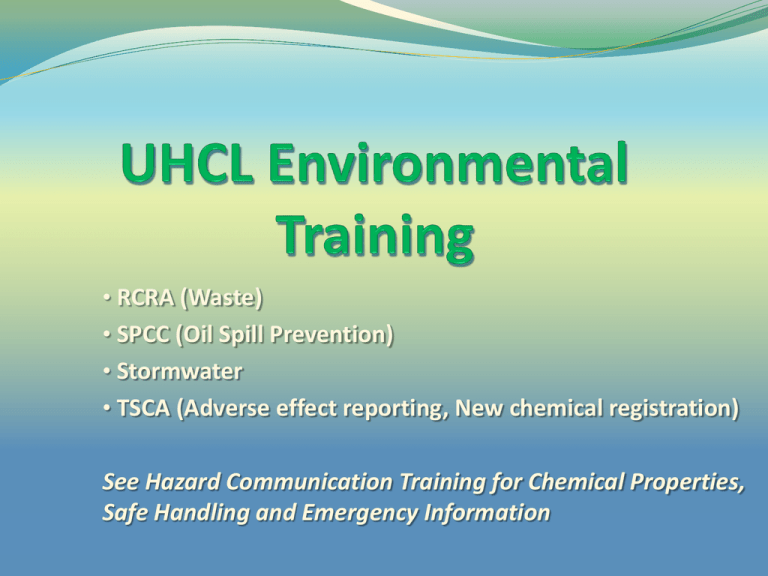
• RCRA (Waste) • SPCC (Oil Spill Prevention) • Stormwater • TSCA (Adverse effect reporting, New chemical registration) See Hazard Communication Training for Chemical Properties, Safe Handling and Emergency Information RCRA Regulations are for handling and disposal of wastes, which are: Discarded solid, liquid or sludge materials whether they are abandoned, a spill not cleaned up, materials not recycled properly, or materials inherently waste-like: intended for disposal, no longer needed and no foreseeable use. Examples: Experiment products/byproducts no longer needed Solutions made specifically for an experiment that is over Containers left open on the bench top or open in the hood Chemicals past their shelf life and the container or contents are starting to degrade Chemicals past their shelf life that haven’t been used in some time and are not likely to be used again anytime soon RCRA requires waste generators be responsible for ensuring the proper treatment of their waste, and that generators are essentially always responsible for it—from “cradle to grave”. RCRA overview: There are Requirements for Treatment, Storage and Disposal of Hazardous and Non-Hazardous wastes. Only those with a permit (and facilities and insurance to do so) may treat and dispose of hazardous waste. Generators are responsible for ensuring their wastes are handled by a licensed Treatment, Storage, and Disposal Facility (TSDF). If waste is improperly disposed of, generators are responsible for paying for cleanup and additional costs to then properly dispose of the waste. Generators can be forced to pay for cleanup of other’s improperly disposed waste in the same location as theirs, if the other generators cannot pay. Examples of Improper Disposal: Sending waste to an Unlicensed / Unpermitted company or person, or someone who does not have the facilities to treat your wastes and test that they meet the air emissions, wastewater discharge and landfill criteria Allowing waste or experiment remnants to Evaporate in a hood Pouring hazardous waste down the sink—our wastewater treatment facility is not permitted to accept hazardous waste. Do NOT pour chemicals into the sink without getting Written Approval from the Clear Lake Water Authority that this is allowed and they can treat it (let EH&S know for approval). Indefinite Storage of chemicals without any anticipated future use for, or chemicals that are no longer useable. Improper inventory upkeep can be viewed as storage in lieu of disposal. Donating unneeded materials. This gets tricky because we could be held responsible for it later. Definitely no donation to individuals and definitely not instead of paying for proper disposal. Classes of Waste: Hazardous Acutely Hazardous Waste Universal(ly) Hazardous Waste (bulbs, batteries, paint, oil, electronics) Non-Hazardous (but still regulated) Chemical and other Waste Hazardous Wastes Toxic—TCLP test of 40 listed chemicals (Benzene, Lead, Mercury…) Reactive—unstable, reacts violently with water or air or potentially explosive Ignitable—liquid flash point <140°F or non-liquid spontaneously combustible at STP Corrosive—liquid with pH <2 or >12.5 Specifically listed as hazardous in regulations Specifically Listed as Hazardous Examples: common solvents like toluene, xylene, acetone; Aniline, Carbon disulfide, Tetrahydrofuran Non-hazardous but still regulated Class 1 Wastes Water leachate test (landfill simulation) of 150 chemicals including Nickel, Lead, ethylene glycol Containing >20ppm reactive Cyanides, or PCB’s >50ppm Total Petroleum Hydrocarbons ≥1500ppm Flammable—liquid F.P. between 140°F and 150°F or readily ignitable solid under normal conditions Corrosive—solid with pH <2 or >12.5 with DI water Name: ______________________ Date Filled: _________________ Contents: _______________________________________________ _______________________________________________________ ___Ignitable (Flash Point <140) ____Corrosive (pH<2 or >12.5) ___Reactive(Explosive, Air/Water reactive, cyanide/sulfide releasing) ___Halogen ___Oxidizer ___Contains metal(s):_______________ Here is our waste label and other important chemical labels. This is the information we need to determine how to properly treat and dispose of waste. High-Hazard Material DO NOT OPEN! Remote Opening & Stabilization Required! PYROPHORIC MATERIAL This material will ignite and burn or react explosively with AIR or WATER EXPLOSIVE MATERIAL This material has the potential to react explosively under certain conditions FEDERAL LAW PROHIBITS IMPROPER DISPOSAL These are waste labels typically used for drums, buckets, or pallets GENERATOR: University of Houston – Clear Lake 2700 Bay Area Blvd Houston, TX 77058-1098 (281) 283-2106 HANDLE WITH CARE Area/Room#: __________________________ Name: ________________________________ Date Started Date Filling: _____________ Filled: _____________ Contents: _____________________________ CHEMICAL WASTES ARE SUBJECT TO TREATMENT AND/OR DISPOSAL THROUGH ENVIRONMENTA L HEALTH & SAFETY GENERATOR: University of Houston – Clear Lake 2700 Bay Area Blvd Houston, TX 77058-1098 (281) 283-2106 Area/Room#: ________________________ Name: _____________________________ Date Started Date Filling: ____________ Filled: ___________ Contents: ____________________________ GENERATOR: BATTERIES, University of Houston – Clear Lake LAMPS, 2700 Bay Area Blvd PAINT & PAINT RELATED MATERIAL, MERCURY SWITCHES Houston, TX 77058-1098 (281) 283-2106 Area/Room#: ___________________________ Name: _________________________________ Date Started Date Filling: _____________ Filled: _____________ Contents: ______________________________ All Waste Containers must: Be Labeled when the First Drop of waste goes in the container Not have any other Contradicting labels Have contents legible and a contact for questions Have the Date marked when filled/finished with the container These are waste labeling regulatory requirements and the information needed so the waste can be properly treated and disposed of according to regulation. Waste is not billed back to the department or individual researcher. Waste Containers must be in good condition: Container must be compatible with the waste, and suitable for storing chemicals (not a household container) Proper fitting, airtight lid kept closed If the container is compromised, pack it in another compatible container or bag and place in containment tray Inventory Containers must also be in good condition, otherwise they need to hit the waste shelf. Review stock chemicals routinely. Here are some indicators: Containers with bulging or bubbly lids Plastic yellow and brittle, bulging or cracked Inverted containers (usually indicates a leak) Liquid contents crystallized or evaporated Waste Segregation: Mixture Rule: one drop of hazardous = hazardous Don’t mix different types of wastes – No cost benefit • Combining wastes in containers can lead to disaster if something incompatible gets added to the container. No Waste Treatment unless you’re a licensed Treatment, Storage and Disposal Facility (TSDF). Cadmium and organic solvent waste bulking explosion example courtesy of another state University. Satellite Accumulation Area: Is any waste area at or near the point of waste generation. Each lab generates waste, so each lab’s waste container areas are considered Satellite Accumulation areas. The specific requirements for waste containers while accumulating/filling them are: Keep closed to prevent evaporation or spillage (if knocked over) Identify Contents (labeled fully per Hazard Communication requirements) and words Non-Hazardous or Hazardous Waste When full, move to storage area. If you should ever have 55gallons of waste, it would have to be moved within 3 days. Waste Storage Area: Solvent Storage Room 3520AA Can store containers up to 180 days (we ship twice a year) Containers must be secured closed and waste label filled out completely with contents, contact name, and date container filled 1) When does the waste label go on? 2) What should you remove if reusing a container for waste? 3) In order to pour any lab materials down the sink, you need ______________________. 4) You have to be sure the waste container is in _____________ and _________________. Choices: a) specific written approval from the wastewater authority b) good condition compatible with contents c) upon first drop waste added to drum d) all other contradicting labels Collect your waste Label It Properly with all contents, properties, and your contact info Keep it closed and in good condition If there’s something you’re unsure about, ask! Lisa Coen, x.2107 Celina Gauthier, x.2104 Requires Management address oil spill prevention and containment of oil discharges via written procedures, work practices, and spill equipment. Owners/Operators are responsible for properly instructing personnel in equipment operation and maintenance to prevent the discharge of oil, and applicable pollution control laws, rules, and regulations (40 CFR 122.7(e)(10)). Oil = any kind or form including, but not limited to petroleum, fuel oil, sludge, oil refuse, oil mixed with wastes other than dredged spoil; Anything that Causes a film or sheen upon or discoloration of the surface of the water Pertains to handling of both new and used oil. Some Organic Chemicals can produce a sheen on water. Examples: Diesel, gasoline, lubricants, WD-40 General Requirements: Keep all oil containers closed when not in use Clean up all spills immediately Don’t store oil/gas containers near waterways or sinks Clear Lake Water Authority must be notified of any “oil” (or chemical) being accidental slug discharged in wastewater Oil releases subject to Reporting Requirements: 210 gals new oil and 25 gals used oil within 15 minutes. Stormwater requirements to keep chemicals, waste, construction sediment and industrial process materials out of stormwater discharging ditches (any ditch on campus) The Goal is to reduce or eliminate hazardous materials and waste from getting into the soil, groundwater, and surrounding waterways All containers exposed to the elements must be in good condition, closed securely, and designed for outdoor storage (to be exposed to precipitation) Any spills are cleaned up promptly and disposed of properly No wastes, soaps, cleaners, etc. on ground or pavement TSCA has requirements for: • Reporting Adverse effects not previously known of a chemical (not mixtures) • New chemical registration for those created or imported for Pilot Scale use (PreManufacture Notification-PMN) • Submitted 90 days before creation/import for approval • Notice of Commencement filed after first batch PMN Exemptions: Small quantities solely for R&D purposes, certain incidental chemical reaction products


